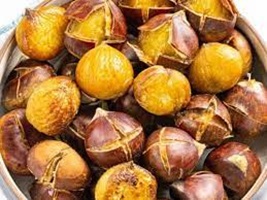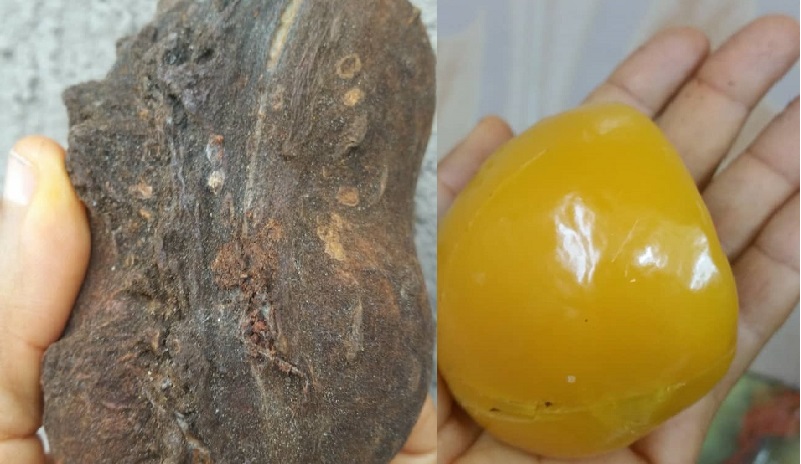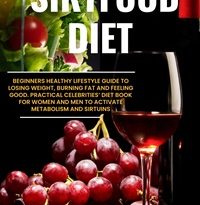Boiled Chestnuts Benefits, Uses, and Side Effects
Boiled chestnuts: Benefits, Uses, and Side Effects
Even after boiling, chestnuts are still a great source of antioxidants. Gallic acid and ellagic acid, two antioxidants that concentrate when cooked, are abundant in them.

Minerals like potassium and magnesium, together with antioxidants, lower your chance of cardiovascular problems like heart disease and stroke.
Boiled Chestnuts: What Are Chestnuts?
An in-depth explanation of “What are Chestnuts?” Tree nuts called chestnuts are native to the Northern Hemisphere’s temperate regions.
Their interior is starchy, and their outside is rough and spiky. People all over the world enjoy the sweet chestnut’s nutty flavor; the nuts are also edible fruit.
Origin of Chestnuts
Nuts of the chestnut variety are native to the Mediterranean region. They were initially grown in central Italy, and other regions of Europe quickly became aware of their appeal.
Early settlers brought chestnuts to North America, and the eastern United States is today home to a large chestnut cultivation.
A staple food for many ancient cultures, including the Greeks and Romans, was chestnuts.
It is believed that the chestnut originated in Greece and then made its way throughout Europe. During the Middle Ages, chestnuts were a staple of European cuisine.
They were boiled or mashed and given as a side dish with meals, and chestnut flour was used to make bread and sweets. Roasted chestnuts were also marketed as a snack.
The chestnut was valuable for forestry purposes in addition to being a food source. Because of its hardness and longevity, chestnut wood is frequently utilized in furniture construction and manufacture.
Unfortunately, a fungal disease known as “chestnut blight” had decimated most of Europe’s chestnut trees by the early 1900s. Because of this, chestnut trees are becoming scarce throughout Europe.
Chestnuts are still a staple of many cuisines and cultures around the world today. They are frequently added to stuffing recipes or used to make roasted chestnuts in the United States during the holiday season.
In Asia, chestnuts are also widely consumed, whether boiled or roasted, and combined with other foods. For convenience, they are also available vacuum-packed and canned. This nut has been relished for ages all across the world, in any shape.
What do chestnuts taste like?
It may surprise you to learn that fresh chestnuts have a unique texture and a delectably sweet flavor. These nuts are not only tasty on their own, but they also go well with a lot of different cuisines.
Chestnuts are an underappreciated nut with tremendous flavor possibilities that are sometimes disregarded.
Their distinct flavor profile, which distinguishes them from other nuts like walnuts or almonds, is due to the natural sugars they possess.
These nuts have unique tastes, but they also have a very unusual texture. When cooked, chestnuts lose some of their firmness and become soft enough to give in under pressure, which makes them ideal for a variety of culinary uses in both savory and sweet recipes.
Types of chestnut
There are numerous varieties of chestnuts, and each has special qualities of its own. The following are a few of the most common varieties you may come across:
American Chestnuts: Before a catastrophic blight that destroyed the majority of the trees in the early 20th century, American chestnuts were widely available in North America and were prized for their sweet and nutty flavor. Still, attempts are being made to bring this cherished variety back to life.
European chestnut: the most prevalent variety of chestnuts to be found in grocery stores. They are frequently used in both savory and sweet recipes, and their flavor is slightly milder than that of American chestnuts.
Chinese Chestnuts: Originally from China, these chestnuts are frequently used in Asian cooking and have a distinctly sweet flavor. Their shell is glossy and smooth, and they are larger.
Japanese chestnuts: are widely valued in the culinary community due to their rich, buttery flavor. They’re frequently roasted or used in desserts that are traditionally Japanese.
Italian Chestnuts: Italian chestnuts are known for their sweet, delicate flavor, and Italy is well-known for producing chestnuts. Italian cuisine frequently uses them, especially in desserts like Mont Blanc.
Chestnuts Nutrition
Not only are chestnuts tasty, but they also provide a lot of nutrients! These little jewels are a heart-healthy snack because they are low in fat and cholesterol. They are a great source of dietary fiber, which promotes better digestion and prolongs feelings of fullness.
In addition, chestnuts are a great source of minerals and vitamins, such as magnesium, potassium, and vitamin C. Potassium maintains appropriate blood pressure levels, while vitamin C strengthens your immune system.
Magnesium is necessary for healthy bones and muscles. Thus, keep in mind that the next time you indulge in some roasted chestnuts, you’re feeding your body as well as your taste buds!
The nutritional value of chestnuts for:
10-kernel (84-gram) serving of roasted chestnuts:
- 206 calories
- 7 grams of protein
- 9 grams of fat
- 5 grams of carbohydrates
- 3 grams of fiber, or 15% of the daily value (DV),
- Copper: 47 percent of the DV
- Mange: 43 percent of the DV
- B6: 25% of the Daily Value
- 24 percent of the Daily Value for Vitamin C
- Thiamine: 17% of the Daily Value
- 15% of the DV is folate.
- Folate: 11% of the Daily Value
- Potassium: 11% of the Daily Value
The health benefits of chestnut
Rich in nutrients
Chestnuts are modest in stature but incredibly nutrient-dense.
Chestnuts are also a good source of phosphorus, magnesium, and several other vitamins and minerals, such as K, B5, and B3.
Because they are low in fat, chestnuts have less calories than most other nuts. In addition, they include more carbohydrates than other nuts and a respectable quantity of fiber—one serving provides 15% of your daily requirements.
could improve cardiac health
May aid health
To begin with, they include ellagic and gallic acids, which are antioxidants. According to studies, these antioxidants may aid in defending the heart against oxidative stress, which can increase the risk of heart attacks and strokes.
With 11% of your daily potassium requirements met chestnuts are also a great source of this mineral. Potassium helps control blood pressure and is essential for a healthy heart.
Furthermore, research indicates that eating a diet high in potassium can reduce the risk of heart disease by up to 27% and the risk of strokes by 24%.
High in fiber
A good source of fiber, which offers numerous health advantages, is chestnuts.
One benefit of fiber is that it gives your stools more volume, which facilitates passage and may help you stay regular.
Furthermore, most of the fiber in your food enters your colon undigested, where it functions as a probiotic. This implies that the good bacteria in your stomach begin to ferment the fiber and use it as a source of nutrition.
Short-chain fatty acids are among the many beneficial substances that are produced by the gut bacteria during the fermentation of fiber. Do chestnuts help people lose weight?
Due to their high fiber content, chestnuts may aid in weight loss by decreasing hunger and slowing down meal digestion. Because they are low in fat, they also have fewer calories than other types of nuts.
Uses for Chestnuts
Roasting chestnuts over an open flame is one of the most popular methods to eat them. Its outer covering is readily cracked apart, exposing the fleshy white core for consumption. Chestnuts, however, can be prepared in a multitude of ways.
They can be boiled and eaten raw, blended and added to a savory dish, or candied for sweet sweets. Additionally, they can be ground into flour and added to bread to create texture. In addition, chestnuts can be deep-fried, grilled, or steam-cooked.
Chestnuts are crushed and sprinkled over meats or salads in a variety of cuisines to enhance the flavor and texture of the food.
The side effects of chestnut are as follows:
- An allergic reaction if you’re allergic to tree nuts.
- Use of pesticides in the absence of organic
- As with any cuisine, make sure to eat in moderation and avoid overindulging.
How can I select the best chestnut?
Try to choose the best chestnuts if you plan to store them, even for a short while.
Although the official chestnut season runs from October to January, you might be able to find them at your neighborhood farmer’s market or grocery store during other times.
If you’re lucky, you can pluck fresh chestnuts straight off the tree, get raw chestnuts from a farm or agricultural market, or purchase them at the grocery shop or health food store. They can also be ordered online and shipped quickly to guarantee they get to your door undamaged.
You can check each fresh chestnut before buying them at the grocery store to make sure there are no bruises, mildew, or other issues.
If you are purchasing in bulk from another vendor, such as a farm stand, make sure the seller has kept the goods in a dry, cool environment to avoid spoilage.
Recall that it’s best to get them as soon as feasible before you intend to utilize them.
It is ideal to buy chestnuts with strong, glossy shells that are free of holes or splits. The chestnut within is probably past its prime if the shell is dull or has any flaws.
If the chestnut feels hefty for its size, that’s something else to think about. This indicates that there is a plump and wet nut inside.
Make sure your chestnuts are firm and have not shriveled to guarantee they are of the highest quality. Chestnuts that have become shriveled will taste bland and dry. If the nut inside your chestnut rattles when you shake it, it may not be as fresh as you would want.
When buying chestnuts, steer clear of sealed plastic bags because they can become moldy due to inadequate airflow.
If you’re buying prepackaged chestnuts, look for ones with holes or those in a mesh bag. This will facilitate better ventilation and stop the growth of mold.
How to store chestnuts the proper way
Make sure they are dry and clean first.
For optimal results, refrigerate uncooked chestnuts in their shells in a paper or mesh bag. Another alternative is a plastic bag with perforations. Any extra moisture can be drained with the use of ventilation holes and a paper towel lining.
Chestnuts should be refrigerated between 33 and 35°F (0.5 and 1.7°C) and kept at a high humidity level of over 90%. Remember that your refrigerator works best at a temperature of 35 to 38°F (1.7 to 3.3°C). It is advised to keep the temperature at or below 40°F (4°C).
It’s a good idea to store your chestnuts in the back of the refrigerator, as that’s where it gets coldest. Another alternative is the vegetable drawer or crisper bin.
Unshelled chestnuts can be stored in the refrigerator for up to two weeks. Their refrigerated shelf life can be increased to three weeks by keeping them in a refrigerator with the right temperature and humidity levels.
Blanching Chestnut
One of the most important steps in storing chestnuts is blanching them. It helps preserve the flavor and texture of the nuts, in addition to making peeling them simpler. Make a little cut on the flat surface of each chestnut before blanching it. Then, gently place the chestnuts in a pot of boiling water. After letting them simmer for around five minutes, place them in an ice bath to cool. The gorgeous chestnut within is immediately visible once the outer shell has cooled. You can now put them away for your upcoming culinary explorations!
Preparing Chestnuts for Storage
- Sorting and Cleaning Chestnuts
Sorting and cleaning the chestnuts is a crucial step in getting them ready for storage. To start, quickly rinse your chestnuts under cold water to get rid of any dirt or debris. Next, examine each chestnut more closely and throw away those that appear damaged, discolored, or shriveled. Keep in mind that your storage store should only contain the nicest and freshest chestnuts!
Consider arranging your chestnuts by size to facilitate the sorting process. When it comes time to roast or prepare them, this will be helpful because similar-sized chestnuts cook more uniformly. Besides, having a tidy collection of chestnuts is satisfying!
Your cleaned and sorted chestnuts are now ready to be kept and eaten anytime you get a need for something nutty.
- Eliminating the External Coat
You must remove the tough outer shells from chestnuts to prepare them for storage. It’s not as difficult as it seems, so don’t worry! Using a sharp knife, make a small incision on the flat side of each chestnut.
This will stop them from blowing up while they’re cooking. After that, cook the chestnuts for around five minutes in a pot of boiling water. The shells will become more pliable after this brief blanching, making removal simpler.
While the chestnuts are still warm, carefully remove the shells after they have been blanched. It’s similar to opening a mouthwatering gift! Your chestnuts are now prepared for storage and the next cooking endeavors.
- Canning Chestnuts
Canning chestnuts is a great way to preserve them for long-term use, so you can enjoy their delicious nutty flavor all year. To make peeling the chestnuts easier, start by blanching them. After peeling, place the chestnuts with some headroom in jars that have been sterilized.
Once the sugar has dissolved in the water, make a syrup solution and cover the chestnuts completely. Place the jars in a water bath canner and screw the lids on securely. Because of the vacuum that the heat creates, your chestnuts will remain delicious and secure for months. Imagine getting a taste of autumn’s abundance in January by breaking open a jar!
How are chestnuts boiled? How to make chestnuts
All you need for boiling chestnuts is water, raw chestnuts, and optional seasonings. But it’s crucial to remember that not every chestnut is made equally.
- Chestnuts: During the fall and winter, fresh chestnuts can be found at farmers’ markets and your neighborhood grocery shop. I tested this recipe for steamed chestnuts using both Chinese and European (mostly Italian) chestnuts, which are readily accessible. Italian chestnuts are easier to peel than Chinese ones, so if you can find them, definitely purchase them. Additionally, American chestnuts would also work if you could find them.
- Seasonings: You can add cinnamon sticks, orange peel, or bay leaves to the boiling water, though they are not required.
- Water: I tap water used.
How to Get Chestnuts Ready to Boil:
Score the chestnuts first. To make peeling later on easier, this is an essential step. Securing a chestnut firmly between your index finger and thumb, place it flat-side down on a cutting board.
Make a small horizontal incision over the rounded side of the chestnut, about ½ inch lengthwise, using a paring knife, chestnut knife, or sharp serrated knife. While cutting through the outer shell and the inner fuzzy skin is desired, try your hardest to avoid making too many cuts through the flesh.
How to Boil?
Boil water in a saucepan: Pour cold water into a saucepan and bring it to a boil. There should be enough water to completely submerge the chestnuts. Heat it until it boils. After putting the chestnuts in the boiling water, cook them for about 15 to 20 minutes, or until the inside fuzzy skin is visible through the opening in the scored area.
Check for doneness: To check if the golden flesh inside a chestnut has cooked all the way through, carefully remove and peel one. The pulp is cooked if it is creamy and soft.
If so, transfer the chestnuts into a bowl using a slotted spoon. Ten minutes should pass while the bowl is covered with a fresh kitchen towel. If it’s still not done, cook it for a further three to four minutes, testing its doneness once or twice while it boils.
how to peel boiled chestnuts?
Peel the chestnuts one at a time, while they are still hot but manageable. Remove the inner skin after removing the outer layer. Re-submerge it in the water for a few more minutes if the fuzzy skin is difficult to remove, or cut off as much of it as you can with a paring knife. This method of peeling chestnuts is labor-intensive and may result in fragmented pieces.
Alternatively, you might cut it in half, use a tiny spoon to scoop out the nuts, and then gather the cooked and steamed chestnuts in a bowl. Even if there are shattered bits, the food will still taste great.
Roasted versus boiled chestnuts?
Chestnuts can be boiled or roasted. Boiling will just facilitate the skin removal process. Roasting is often preferable since it adds more taste to the chestnuts.
Are chestnuts good for losing weight?
Due to their high fiber content, chestnuts may aid in weight loss by decreasing hunger and slowing down meal digestion. Because they are low in fat, they also have fewer calories than other types of nuts.
There are many advantages to these short-chain fatty acids. According to studies, they may enhance blood sugar regulation, lessen inflammation, and support gut health.
Finally, fiber does not contribute calories to your diet because it mostly goes through your body undigested. Rather than adding calories to your diet, it increases feelings of fullness, which may aid in managing your weight.
Boiled Chestnuts: Are boiled chestnuts good for you
even after heating, chestnuts are still a good source of antioxidants. Gallic acid and ellagic acid, two antioxidants that concentrate when cooked, are abundant in them.
Minerals like potassium and magnesium, together with antioxidants, lower your chance of cardiovascular problems like heart disease and stroke.
Boiled Chestnuts: Boiled chestnuts recipes: is it better to roast or boil chestnuts?
How should chestnuts be prepared? The best approach to extract the maximum flavor from chestnuts is to roast them in the oven (whether you want to eat them right away or slice them up to add to your stuffing mixture).
They will cook into a smooth texture when boiled and used in soups or purées.
The glycemic index of boiled chestnuts
Furthermore, the glycemic index of chestnuts is a low 54. When you eat foods lower on the glycemic index, your blood sugar levels won’t move significantly.
Boiled chestnuts instant pot: can you boil chestnuts in a pressure cooker?
In a pressure cooker, you may quickly get the incredibly soft texture of boiled chestnuts. All the water needed to submerge the scored nuts inside the cooker is what’s needed.
After bringing to pressure, cook for eight minutes. After that, strain the water and use a towel to peel the nuts while they’re still warm.


